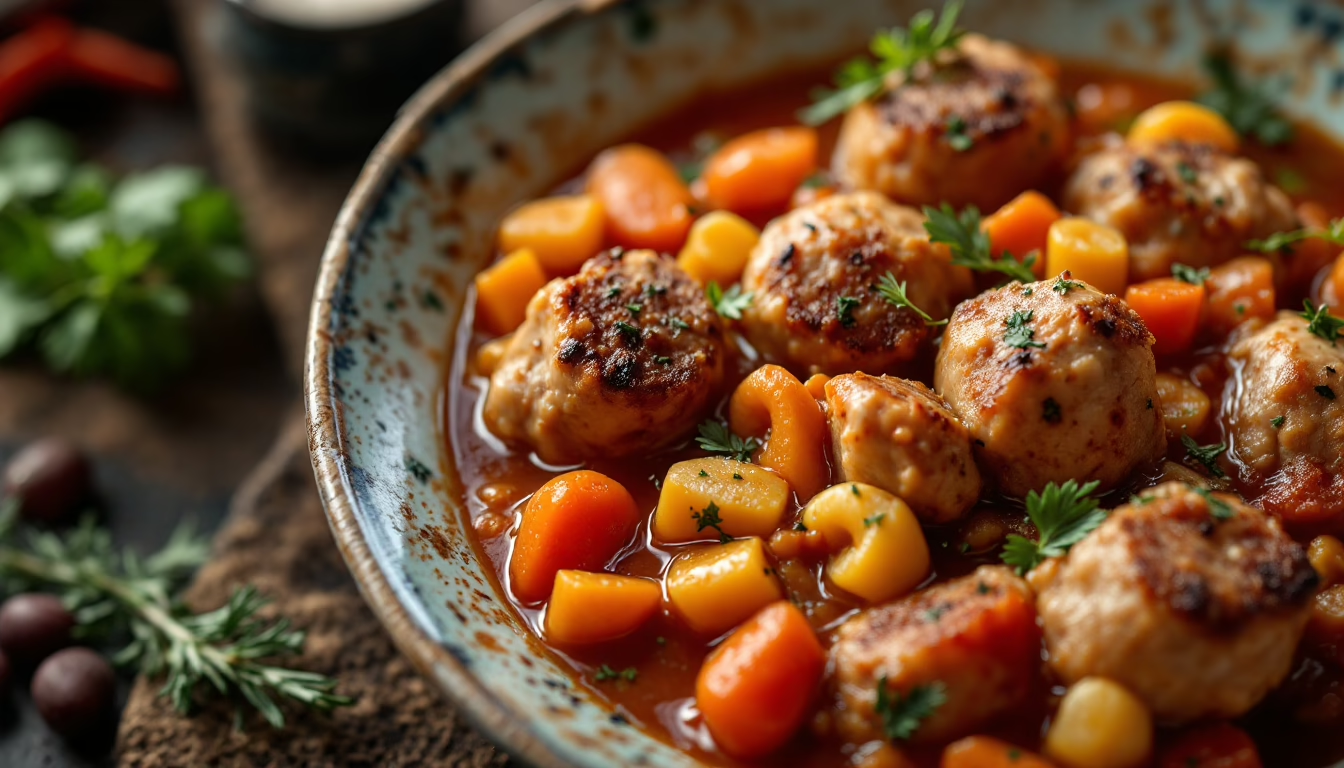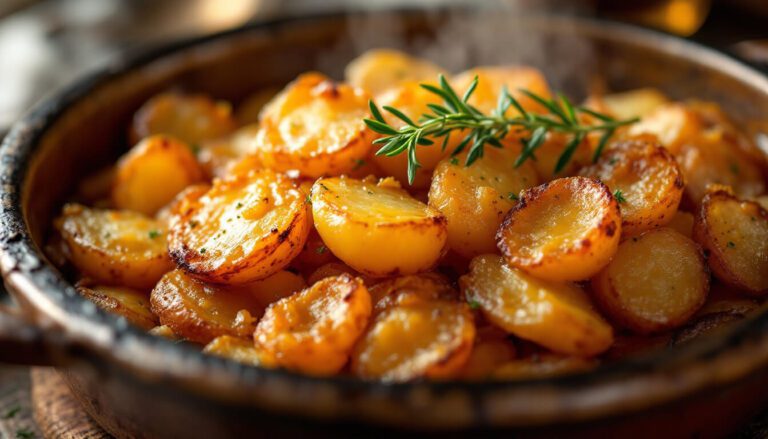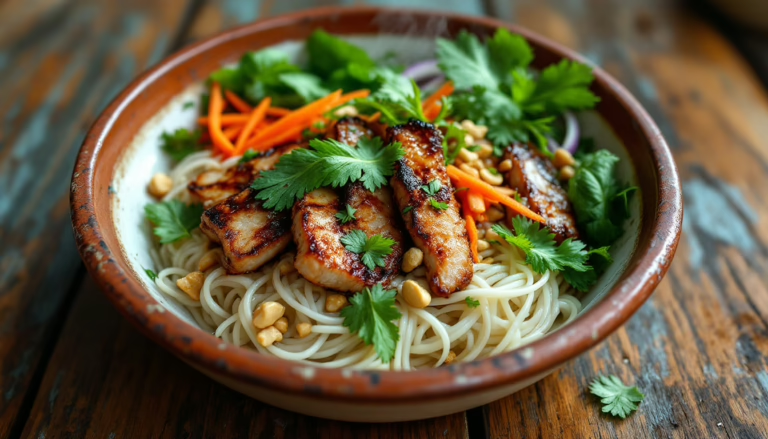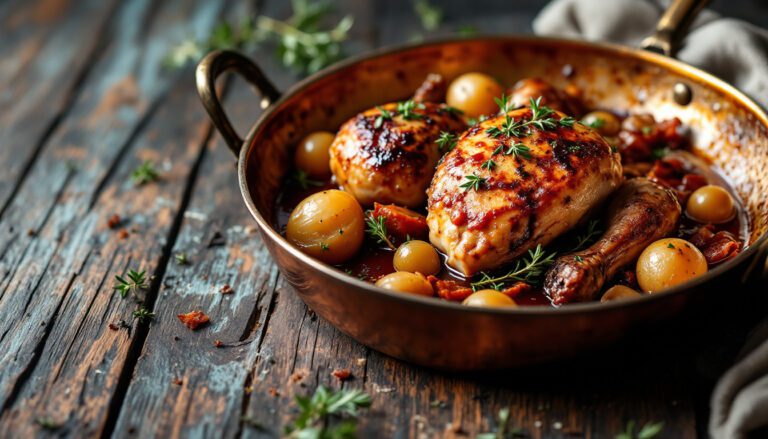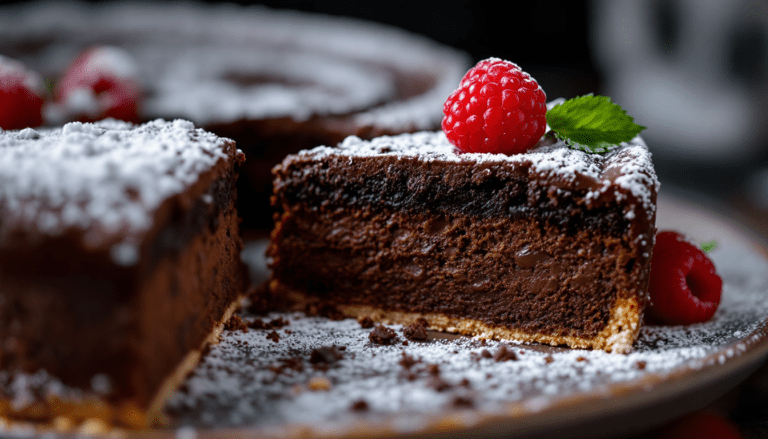Pork Cassoulet Recipe
The Lazy Weekend Pork Cassoulet Recipe That Changed My Mind About French Cooking – Let me tell you about the time I nearly gave up on French cooking entirely.
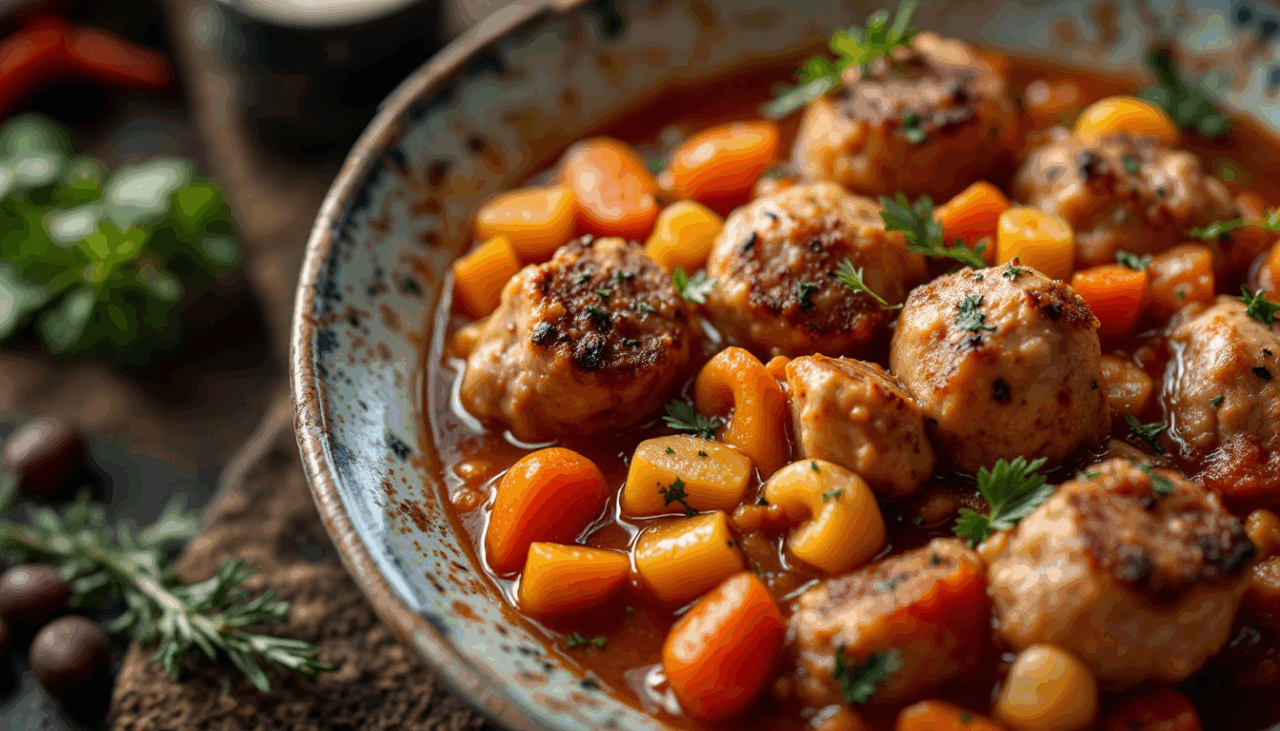
Pork Cassoulet
Ingredients
- 4 tbsp goose fat
- 350g pork, diced
- 1 large onion, sliced
- 10 garlic cloves, whole
- 1 carrot, thinly sliced
- 1 tsp fennel seeds
- 2 tbsp red wine vinegar
- 600ml vegetable stock
- 1 tbsp tomato puree
- 2 sticks rosemary
- Handful parsley
- 400g haricot beans
- 2 tbsp breadcrumbs
- Oil for drizzling
- Crusty bread to serve
- Broccoli to serve
Instructions
- Heat oven to 140C/120C fan/gas 1. Put a large ovenproof pan (with a tight-fitting lid) on a high heat. Add your fat and diced meat, cook for a few mins to seal the edges, giving it a quick stir to cook evenly.
- Reduce the heat to low, add the sliced onion, whole garlic cloves, carrot and fennel seeds, and cook gently to soften the veg for a few mins.
- Pour over the red wine vinegar, scraping any meaty bits off the bottom of the pan. Add the stock, tomato puru00e9e, and half the rosemary and parsley. Bring to the boil and simmer for 10 mins, then season, cover with a lid and put into the oven for 2 hrs, removing the lid for the final hour of cooking.
- Stir occasionally and add the beans with 30 mins to go. Remove the pan from the oven and heat the grill.
- Scatter the top with the remaining herbs and breadcrumbs, drizzle a little oil over the top, and return to the oven for 5-10 mins, until the breadcrumbs are golden. Serve with crusty bread and green veg.
Nutrition
It was a rainy Tuesday evening, and I was standing in my kitchen surrounded by what looked like the aftermath of a culinary tornado — bowls everywhere, my cutting board covered in duck fat (yes, duck fat, because I was being ambitious), and three different cookbooks open to cassoulet recipes that might as well have been written in ancient Sanskrit for all the sense they made to me.
I had been attempting this classic French dish for the better part of four hours, and my beans were still as hard as pebbles, my meat was somehow both dry and swimming in grease, and I was questioning every life choice that led me to think I could master a dish that French grandmothers spend literal days perfecting.
That’s when my neighbor knocked on my door with a steaming bowl of what she called her “lazy weekend pork cassoulet recipe” — and friends, it was a revelation.
Here was this soul-warming, deeply satisfying dish that tasted like it had been simmering in a French farmhouse kitchen for generations, but she’d made it in under three hours with ingredients I could actually find at my regular grocery store.
No duck confit, no special beans that required overnight soaking and a prayer to the cassoulet gods. Just good, honest pork, some pantry staples, and a technique so forgiving that even my Tuesday-evening-disaster-prone self couldn’t mess it up.
Why This Pork Cassoulet Recipe Actually Works
The thing about traditional cassoulet is that it’s absolutely magnificent — and absolutely terrifying for the average home cook. Born in the Languedoc region of southern France, this dish has been the subject of heated debates for centuries.
Should it contain duck? Goose? What about the beans — do they need to be Tarbais beans specifically, or will navy beans suffice? How many times should you break the crust that forms on top? (Some traditionalists insist on breaking it seven times, which feels a bit like kitchen witchcraft to me.)
Here’s what I’ve learned after making more cassoulets than any reasonable person should attempt: the heart of this dish isn’t about fancy ingredients or precise rituals. It’s about slow, gentle cooking that transforms humble ingredients into something extraordinary.
This pork cassoulet recipe embraces that philosophy while keeping your sanity intact.
We’re using readily available pork shoulder, which becomes fork-tender during the long braise, and canned beans (gasp!) that we add strategically to avoid the mushy mess that can happen with dried beans.
The genius of this particular version lies in its restraint. Instead of the overwhelming ingredient list that can make cassoulet feel like a weekend project, we’re focusing on building deep, complex flavors through proper browning, aromatics, and time.
- Warm and Spicy: Lamb, Tomato, and Sweet Spices Recipe
- Mbuzi Choma Recipe: The Unexpected Delight of Kenyan Roasted Goat
- Easy Pad See Ew Recipe: Better Than Takeout Thai Noodles
- The Humble Breakfast Potato Recipe: My Morning Salvation
- The Best Venetian Duck Ragu Recipe You’ll Ever Try
- Cozy Nights and Smoky Lentil Chili with Squash Recipe
The fennel seeds add a subtle licorice note that makes people wonder what your secret ingredient is, while the red wine vinegar brightens everything and prevents the richness from becoming cloying.
The Step-by-Step Pork Cassoulet Recipe
This recipe serves 4-6 people generously and takes about 3 hours from start to finish, though most of that time is hands-off oven time — perfect for a lazy weekend when you want to fill your house with incredible smells while you catch up on reading or organize that junk drawer you’ve been avoiding.
Ingredients You’ll Need
Now, here’s the ingredients for both the base and the toppings:
For the base:
- 4 tablespoons goose fat (or olive oil if you can’t find goose fat — I won’t tell)
- 350g pork shoulder, diced into 2-inch chunks
- 1 large onion, sliced
- 10 garlic cloves, left whole (trust me on this)
- 1 carrot, thinly sliced
- 1 teaspoon fennel seeds
- 2 tablespoons red wine vinegar
- 600ml vegetable stock
- 1 tablespoon tomato purée
- 2 rosemary sprigs
- A generous handful of fresh parsley
- 400g tin of haricot beans (or navy beans), drained and rinsed
For the topping:
- 2 tablespoons breadcrumbs (panko works beautifully here)
- A drizzle of olive oil
- Remaining herbs, roughly chopped
The Cooking Process
First things first — heat your oven to 140C/120C fan/gas 1. This low, gentle heat is crucial for developing the silky, fall-apart texture that makes cassoulet so irresistible.
While the oven heats, get your largest ovenproof pan (with a tight-fitting lid) ready. If you don’t have a proper Dutch oven, a heavy-bottomed casserole dish will work, though you might need to transfer everything later.
Place your pan over high heat and add the goose fat. I know goose fat sounds fancy, but it’s increasingly available in supermarkets and adds an incredible depth of flavor.
If you can’t find it, don’t stress — good olive oil will work perfectly fine. The key here is to get the fat properly hot before adding the meat.
Add your diced pork to the hot fat and let it sear undisturbed for 2-3 minutes. I know it’s tempting to poke and prod, but resist the urge.
We want those beautiful caramelized edges that add so much flavor to the final dish. Give the meat a quick stir to cook evenly, then reduce the heat to low.
Building the Flavor Foundation
Now comes the fun part — adding all those aromatics that will transform your kitchen into a French countryside dream.
Add the sliced onion, whole garlic cloves, sliced carrot, and fennel seeds to the pan. The garlic cloves will become sweet and jammy during the long cooking process, so don’t worry about chopping them.
Cook everything gently for about 5 minutes, stirring occasionally, until the vegetables start to soften and become fragrant.
Pour in the red wine vinegar — this is where the magic happens. As the vinegar hits the hot pan, it will deglaze all those lovely browned bits stuck to the bottom.
Use a wooden spoon to scrape up every bit of caramelized goodness. This step is crucial for building the complex, layered flavor that makes this pork cassoulet recipe so special.
Add the vegetable stock, tomato purée, and half of your rosemary and parsley. The tomato purée adds depth and a subtle richness without making the dish taste like tomato soup.
Bring everything to a boil, then let it simmer for 10 minutes. This initial simmer helps meld all the flavors and reduces the liquid slightly.
The Long, Slow Transformation
Season generously with salt and pepper — this is your chance to taste and adjust. Remember that the flavors will concentrate during the long cooking process, so don’t oversalt at this stage.
Cover with the lid and slide the whole thing into your preheated oven for 2 hours.
Here’s where this recipe gets beautifully hands-off. For the first hour, leave the lid on to create a gentle, steamy environment that will make your pork incredibly tender.
Remove the lid for the final hour of cooking — this allows the top to develop a slight crust while the liquid reduces to a rich, glossy sauce.
Set a timer to stir occasionally (every 30 minutes or so) and add the beans with 30 minutes left to go. The beans need just enough time to absorb the flavors without turning to mush.
This timing is crucial — add them too early and they’ll disintegrate; too late and they’ll taste like an afterthought.
Expert Tips for Cassoulet Success
After making this dish more times than I care to admit (and learning from quite a few disasters), here are the tips that will make the difference between good cassoulet and absolutely incredible cassoulet.
Choosing and Preparing Your Pork
Pork shoulder is your best friend here — it has enough fat to stay moist during the long cooking process and enough connective tissue to break down into silky, tender pieces.
Ask your butcher to cut it into 2-inch chunks, or do it yourself with a sharp knife. Don’t trim all the fat — we want some of that richness in our final dish.
If you can’t find pork shoulder, pork butt or even thick-cut pork chops will work, though you might need to adjust the cooking time slightly. The key is to choose cuts that can handle long, slow cooking without drying out.
The Bean Situation
I know using canned beans feels like cheating, but hear me out. Good quality canned haricot beans (or navy beans) save you hours of soaking and pre-cooking, and they’re less likely to fall apart during the long braise.
Rinse them thoroughly before adding to remove any excess sodium and that slightly metallic canned taste.
If you’re determined to use dried beans, soak them overnight and partially cook them before adding to the cassoulet. They should be tender but still hold their shape — about 75% cooked before they go into the pot.
Temperature Control is Everything
The low oven temperature is non-negotiable. I learned this the hard way when I tried to speed things up at 180C and ended up with tough, chewy pork and beans that had disintegrated into mush.
The gentle heat allows the collagen in the meat to break down slowly, creating that incredible, silky texture.
If your oven runs hot, drop the temperature by 10-15 degrees. You want a gentle simmer, not a rolling boil.
The Final Flourish
The breadcrumb topping isn’t just for show — it adds a delightful textural contrast to the tender meat and beans beneath. Use day-old bread that you’ve blitzed in a food processor, or good-quality panko breadcrumbs.
The brief stint under the grill creates a golden, crispy top that contrasts beautifully with the rich stew below.
Delicious Variations to Try
Once you’ve mastered this basic pork cassoulet recipe, the variations are endless. Here are a few of my favorites that have become regular rotations in our house.
Chorizo and White Bean Cassoulet
Replace half the pork with good-quality chorizo (the firm, Spanish kind, not the soft Mexican variety).
The smoky paprika in the chorizo adds an incredible depth of flavor and turns this into a completely different dish. Add the chorizo in the last 30 minutes of cooking to prevent it from becoming too soft.
Root Vegetable Cassoulet
Add chunks of parsnip, turnip, or sweet potato along with the carrots. Root vegetables hold up beautifully to long cooking and add natural sweetness that balances the richness of the pork.
This version is particularly gorgeous in the fall when these vegetables are at their peak.
Herb-Heavy Garden Cassoulet
Double or triple the fresh herbs and add some thyme and sage along with the rosemary and parsley.
This version feels lighter and more spring-like, perfect when you’re craving comfort food but want something that doesn’t feel too heavy.
Quick Weeknight Version
Use a pressure cooker or Instant Pot to cut the cooking time down to about 45 minutes. Brown the meat using the sauté function, add all the other ingredients except the breadcrumbs, and cook on high pressure for 30 minutes with a natural release.
Finish under the grill with the breadcrumb topping.
What to Expect (And How to Serve)
Let’s be realistic about what you’re getting into here. This isn’t a quick weeknight dinner — it’s a weekend project that rewards patience with incredible results.
Your house will smell absolutely amazing for hours, and you’ll have neighbors “stopping by” with suspicious frequency.
The finished cassoulet should be rich and deeply flavored, with meat so tender it falls apart at the touch of a fork. The sauce should be thick enough to coat the back of a spoon but not gluey.
If it seems too thin, simmer it uncovered on the stovetop for a few minutes. Too thick? Add a splash of stock or water.
Serve this with crusty bread — the kind with a really good crust that can handle being dragged through all that delicious sauce. A simple green salad or steamed broccoli provides a nice contrast to all that richness, though honestly, sometimes I just eat it with more bread and call it a day.
Leftovers (if you’re lucky enough to have any) are even better the next day. The flavors continue to meld and deepen, and it reheats beautifully either in the oven or on the stovetop with a splash of stock.
This pork cassoulet recipe has become one of those dishes I turn to when I want to feel like I’ve really accomplished something in the kitchen. It’s impressive enough for dinner parties but comforting enough for a quiet Sunday at home.
Most importantly, it’s forgiving enough that even if things don’t go exactly according to plan, you’ll still end up with something delicious.

